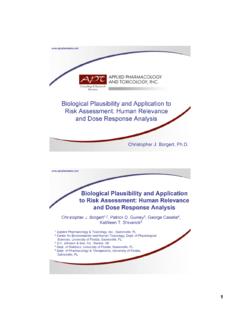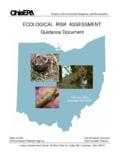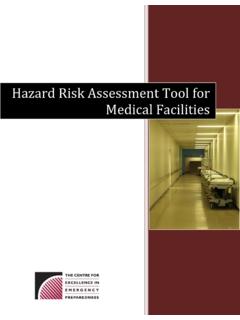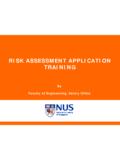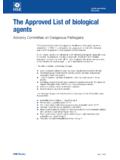Transcription of MICROBIOLOGICAL RISK ASSESSMENT SERIES 16
1 INTERPRETATIVE SUMMARYAND TECHNICAL REPORTRisk ASSESSMENT of Vibrio parahaemolyticus in seafood16 MICROBIOLOGICAL RISK ASSESSMENT SERIES16 ISSN 1726-5274 For further information on the joint FAO/WHO activities on MICROBIOLOGICAL risk ASSESSMENT , please contact:Nutrition and Consumer Protection DivisionFood and Agriculture Organization of the United NationsViale delle Terme di Caracalla00153 Rome, ItalyFax: +39 06 : Web site: Department of Food Safety and Zoonoses World Health Organization20, Avenue Appia1211 Geneva 27 SwitzerlandFax: +41 22 : site: design: Food and Agriculture Organization of the United Nations and the World Health Organization Cover picture: Dennis Kunkel Microscopy, HEALTH ORGANIZATIONFOOD AND AGRICULTURE ORGANIZATION OF THE UNITED NATIONS201116 INTERPRETATIVE SUMMARY AND TECHNICAL REPORTRisk ASSESSMENT of Vibrio parahaemolyticus in seafoodMICROBIOLOGICAL RISK ASSESSMENT SERIESThe designations employed and the presentation of material in this information product do not imply the expression of any opinion whatsoever on the part of the Food and Agriculture Organization of the United Nations or of the World Health Organization concerning the legal or development status of any country, territory, city or area or of its authorities, or concerning the delimitation of its frontiers or boundaries.
2 7KH PHQWLRQ RI VSHFL F FRPSDQLHV RU SURGXFWV RI PDQXIDFWXUHUV ZKHWKHU RU QRW WKHVH KDYH been patented, does not imply that these have been endorsed or recommended by FAO or WHO in preference to others of a similar nature that are not reasonable precautions have been taken by the World Health Organization and the Food and Agriculture Organization of the United Nations to verify the information contained in this publication. However, the published material is being distributed without warranty of any kind, either expressed or implied. The responsibility for the interpretation and use of the material lies with the reader. In no event shall the World Health Organization or the Food and Agriculture Organization of the United Nations be liable for damages arising from its use.
3 This report contains the collective views of an international group of experts and does not necessarily represent the decisions or the stated policy of FAO or of WHO. WHO Library Cataloguing-in-Publication DataRisk ASSESSMENT of Vibrio parahaemolyticus in seafood: interpretative summary and technical report.( MICROBIOLOGICAL risk ASSESSMENT SERIES no. 16) parahaemolyticus. microbiology. contamination. ASSESSMENT . Health Organization. and Agriculture Organization of the United Nations. ,6%1 :+2 1/0 FODVVL FDWLRQ 4: ISBN 978-92-5-106874-8 (FAO)ISSN 1726-5274 Recommended citationFAO/WHO [Food and Agriculture Organization of the United Nations/World Health Organization]. 2011. Risk ASSESSMENT of Vibrio parahaemolyticus in seafood: Interpretative summary and Technical report.
4 MICROBIOLOGICAL Risk ASSESSMENT SERIES No. 16. Rome. 193ppAll rights reserved. Reproduction and dissemination of material in this information product for educational or other non-commercial purposes are authorized without any prior written permission from the copyright holders provided the source is fully acknowledged. Reproduction of material in this information product for resale or other commercial purposes is prohibited without written permission of the copyright holders. Applications for such permission should be addressed to Chief, Electronic Publishing Policy and Support Branch, Communication Division, Food and Agriculture Organization of the United Nations, Viale delle Terme di Caracalla, 00153 Rome, Italy or by email to FAO and WHO 2011 iii Contents Foreword ixAcknowledgements xiRisk ASSESSMENT Drafting Group xiiReviewers (Participants in expert consultations)
5 XiiiPeer reviewers xvAbbreviations used in the text xvii INTERPRETATIVE SUMMARYI ntroduction 3 Statement of purpose 3 Constraints 3 Hazard identification 5 Exposure Assessments 6 Exposure ASSESSMENT for raw oysters 6 Exposure ASSESSMENT for Bloody clam 8 Exposure ASSESSMENT for horse mackerel 8 Hazard characterization 9 Risk characterization 10 Raw oysters 10 Bloody clam 12 Horse mackerel 12 Impact of establishing limits for the level of V. parahaemolyticus in oysters 13 Using the risk ASSESSMENT tool to inform industry process regimes 14 Key outcomes of the risk ASSESSMENT 15 Raw oyster risk ASSESSMENT 15 Bloody clam risk ASSESSMENT 15 Horse mackerel risk ASSESSMENT 15 Gaps in the data 16 Current and future issues influencing risk ASSESSMENT and management of V.
6 Parahaemolyticus in oysters 17 References for Interpretative Summary 21 iv TECHNICAL REPORTPart I MICROBIOLOGICAL risk ASSESSMENT of Vibrio parahaemolyticus in raw oystersIntroduction and scope 29 Statement of purpose 29 Constraints 29I 1. Hazard identification 29I Human incidence 30I Foods implicated 30I 2. Exposure ASSESSMENT 32I Microbial ecology 32I Growth and survival characteristics 33I Growth rate 34I Death and inactivation 36I Prevalence in water, sediment and shellfish 36I Consumption of oysters 38I Modelling exposure to V.
7 Parahaemolyticus 38I Approaches 38I Assumptions 39I Harvest module 41I Effect of water temperature and salinity on prevalence 42I Water Temperature Distributions 51I Prediction of the distribution of pathogenic V. parahaemolyticus numbers 53I Post-harvest 55I Growth of V. parahaemolyticus from harvest to first refrigeration 56I Distribution of ambient air temperature 56I Distribution of time oysters are left unrefrigerated 57I Growth of V. parahaemolyticus during cooling 59I Change in V. parahaemolyticus population during cold storage 61I Consumption 62I Mitigation strategies 63I 3. Hazard characterization 64I Description of the pathogen, host, and food matrix factors and how these influence the disease outcome 64I Characteristics of the pathogen 64I Characteristics of the host 65I Characteristics of the food matrix 68 v I Public health outcomes 68I Manifestations of disease 68I Rationale for the biological end points modelled 70I Dose-response relationship 72I Summary of available data 72I Dose-response model 72I 4.
8 Risk characterization 75I Predicted illnesses from oysters consumed in countries of study 75I Predicted surveillance results and under-reporting factors 79I 5. Impact of establishing limits for the level of V. parahaemolyticus in oysters 80I Caveats 81I 6. Discussion and conclusions 82I Key outcomes of the risk ASSESSMENT 82I Gaps in the data 83I 7. Current and future issues influencing risk ASSESSMENT and management of V. parahaemolyticus in oysters 84I 8. References for Part I Oysters 88 Appendix I 1 Impact of non-compliance in establishing limits for the level of V. parahaemolyticus in oysters 100 Appendix I 2 Evaluating the effectiveness of V.
9 Parahaemolyticus control measures 102 Appendix I 3 Information on the model used for this ASSESSMENT 103 vi Part II MICROBIOLOGICAL risk ASSESSMENT of Vibrio parahaemolyticus in Anadara granosa (Bloody clam)II 1. Introduction 107II 2. Scope 107II 3. Hazard identification 108II 4. Available data 110II Food implicated 110II Prevalence of V. parahaemolyticus 112II Concentration of total and virulent V. parahaemolyticus at harvest and retail stages 114II Growth during transportation from harvest to retail, and from retail to cooking 114II Cooking (boiling) process 115II Consumption of Bloody clam 115II Dose-response data 117II Summary of available data 118II 5.
10 Possible models that could be made with the available data and the questions they could answer 119II Farm-to-fork style model 119II Estimation of fractional reduction in human cases of V. parahaemolyticus due to changes in clam processing 120II 6. Farm-to-fork style model 121II Proportions of all V. parahaemolyticus cfu in Bloody clam that were virulent strains (tdh+ or trh+ strains) 122II Total V. parahaemolyticus cfu in clams at retail (Nr) 122II V. parahaemolyticus growth rate with temperature 123II Number of pathogenic cfu in a random clam at the point of consumption 123II The fraction of Bloody clam meals that are improperly cooked 124II Number of pathogenic V.












